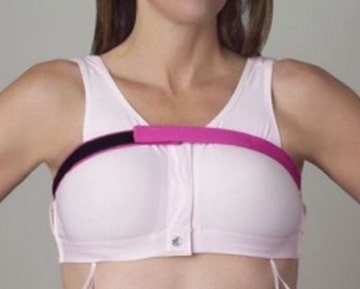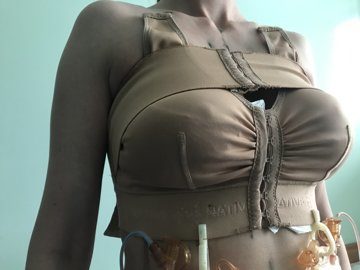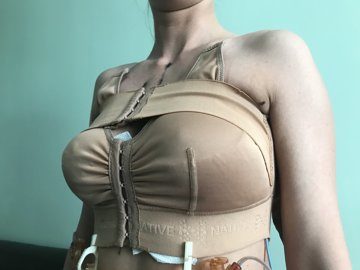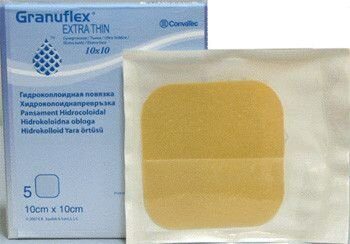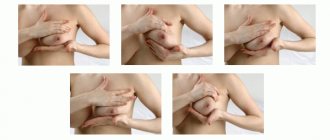Veins are half of the circulatory system.
It is also a source of concern for millions of people around the world.
Vein diseases are widespread. Scientists estimate that up to 15% of middle-aged men and 30% of middle-aged women suffer from varicose veins - dilation of the vessels of the venous system. Among the elderly, the proportion of patients with venous diseases is even higher.
Therefore, many people turn to doctors to treat swollen blood vessels. Sometimes with the help of surgery. In other cases - conservative therapy consisting of medications, exercises and special underwear.
We'll talk about stockings for varicose veins later. In the meantime, let’s evaluate the danger of the disease and its possible complications.
Varicose veins can affect any part of the venous system, but its favorite target is the vessels of the legs.
The vulnerability of veins is explained simply.
When blood flows through the arteries to the organs, it mainly moves downwards. That is, the force of attraction helps blood flow and therefore blood does not usually accumulate in the arteries. It flows through the arteries to the feet. The blood rises back through the veins. At this moment, problems begin - the force of gravity slows down the blood flow, and some of the blood constantly strives to flow down.
The situation is not dire. Yes, blood circulation in the veins is difficult, but the body has protective mechanisms against such trouble.
Venous valves grow inside the vessels, which close the passage of flowing blood and return it to the bloodstream. Muscles also help blood move. They contract and put pressure on the veins, and as a result, blood circulation improves.
In diseased vessels, blood flow is impaired. This happens for various reasons:
- Long immobility
- Obesity
- Elderly age
- Pregnancy
- Hormonal imbalance
In varicose veins, the valves are usually weakened or damaged. Therefore, blood accumulates in certain areas of the vessels, puts pressure on the venous walls and causes expansion.
The symptoms are not the most severe at first:
- Feeling of heaviness in the legs
- Blue or purple blood vessels appear on the skin
- Convulsions
- Edema
- Change in skin color
- Itching and burning in the veins
Such signs of illness often go unnoticed, and sometimes people simply get used to them. Thus, they allow varicose veins to develop.
Yes, it may take more than one year for more severe symptoms to appear. But without treatment, complications are inevitable, and they are not at all as harmless as the first manifestations of varicose veins.
Consequences of advanced varicose veins:
- Trophic ulcers
Non-healing wounds near diseased vessels. The tissues do not receive the necessary nutrients and gradually die. A symptom of an ulcer is the area of skin turning white. To stop the development of complications, you need to consult a doctor as soon as possible.
- Bleeding
Enlarged superficial veins sometimes burst. Bleeding from such vessels is not very severe, but medical attention is still necessary.
- Blood clots
Dilated vessels are a comfortable environment for blood clots, which doctors call thrombi. These formations interfere with blood circulation. They also sometimes come off and can get into the lungs with blood. This phenomenon is called pulmonary embolism and it often leads to breathing problems and even death.
The further the disease progresses, the higher the risk of complications. Another problem is that developed varicose veins usually cannot be eliminated with conservative treatment and surgery is required.
It is much easier to deal with it at an early stage. Complex treatment using stockings against varicose veins shows excellent results. This underwear is also useful for preventing illness.
What are compression stockings for?
This knitwear improves blood circulation in the legs. As a result, pain and swelling that bother many people are reduced. Underwear also helps against more serious diseases, for example, they reduce the risk of deep vein thrombosis and the likelihood of blood clots.
Elastic stockings for varicose veins are made of a special material that stretches well and fits the leg. Knitwear gently compresses the veins. Typically, underwear puts the most pressure on the ankles, with less pressure up the leg.
Doctors prescribe compression stockings for different purposes:
- Vein support
- Prevention of blood accumulation
- Prevention of trophic ulcers
- Combating venous hypertension
- Improved lymphatic drainage
When knitwear puts pressure on blood vessels, it has several positive effects:
- Reduces vein diameter
Blood flows faster through narrow vessels. Therefore, it extremely rarely accumulates in one place and blood clots almost never occur.
- Improves blood flow
Thanks to the additional pressure, the blood moves faster and travels faster from the feet to the heart.
- Prevents blood from draining
Despite the force of gravity, blood rarely flows down the veins and does not fill the connecting vessels.
Even some athletes use compression stockings in their training. For example, runners and basketball players. Underwear protects tissues from damage and accelerates the delivery of oxygen to muscles. After training, muscles recover faster.
Of course, compression stockings for varicose veins cannot be considered a magical artifact that will save you from any problems with blood vessels. Unfortunately, it is not. Like other medical products, compression stockings are not suitable for everyone.
What are compression garments and why are they needed?
Compression stockings belong to the group of therapeutic and prophylactic products that are made from special innovative materials that provide an anti-embolic effect. Before the advent of stockings, compression was achieved through the use of elastic bandages. Unlike the latter, compression stockings, which can be bought today in almost any specialized store, have significant advantages, practicality in use and a longer service life.
Compression stockings are needed to provide support to weakened veins and muscles. Due to graduated compression technology, compression products increase blood outflow and normalize general blood circulation, preventing the formation of blood clots.
The advantages of compression stockings are as follows:
- High-quality support for venous and vascular walls;
- Activation of blood circulation in the lower extremities;
- Prevention of further expansion of veins;
- Support muscle tone and soft tissue;
- Reducing pain, heaviness and fatigue in the legs;
- Prevention of cramps in the calf muscles;
- Treatment and prevention of spider veins.
Indications and contraindications for wearing compression garments
Do not buy shaper stockings yourself. First, go to the doctor and check what kind of jersey you need.
Find out the size. Compression ratio. And other characteristics of underwear that you will wear for months.
Buying knitwear without a doctor's recommendation can harm blood vessels. For example, stockings put too much pressure, and as a result, blood circulation in the veins will be disrupted even more. The result is that the condition of the blood vessels worsens.
Make an appointment with a phlebologist about choosing compression garments. Also, read the indications and contraindications for such stockings.
Indications
Doctors prescribe shapewear for the following diseases:
- Chronic venous insufficiency
- Phlebeurysm
- Deep vein thrombosis
- Lymphedema
- Phlebitis
- Lipodermatosclerosis
Also, knitwear is sometimes prescribed to healthy people who are at risk for vascular diseases. The need for stockings arises:
- During pregnancy
The body of the expectant mother is subjected to great stress. Hormonal balance is disrupted. This causes the venous walls to weaken and often expand. The amount of blood in the body also increases. Because of the child. The increased volume of blood greatly increases the load on the walls of blood vessels. Knitwear helps the veins maintain their normal shape under such high pressure.
- Due to increased stress on the legs
At work, many people have to stand on their feet for a long time and therefore the pressure on the vessels of the lower extremities increases. Frequent exercise can cause varicose veins. The underwear supports the veins. So they remain healthy even in people who spend the entire working day on their feet.
- With a sedentary lifestyle
The less a person moves, the more difficult it is for veins to pump blood. The muscles do not work and do not improve blood circulation, so the blood often accumulates and dilates the blood vessels. Knitwear stops the swelling of veins.
- After vascular surgery
The success of surgical treatment largely depends on the correct recovery of the patient. When the procedure is completed, the doctor prescribes knitwear. It must be worn strictly on schedule, since any violation of the regimen can lead to a relapse of the disease.
The correct choice of elastic underwear is very important. Phlebologists prescribe knitwear of a certain degree of compression and class, depending on the patient’s disease and risk factors.
Contraindications
For most people, compression stockings are completely safe. They have only a few restrictions:
- Suspicion of peripheral arterial disease or already diagnosed
- Severe peripheral neuropathy
- Extensive swelling of the legs or pulmonary edema after heart failure
- Allergy to knitwear material
- Skin and soft tissue problems: gangrene, dermatitis, severe cellulite
Some patients simply cannot wear elastic undergarments effectively.
Sometimes only temporarily. For example, they have wounds on their leg and need to wait for them to heal.
In other cases - constantly. For legs of an unusual shape or with deformation, compression hosiery is not suitable. It simply does not grip the limbs properly and therefore will be useless against vein disease.
How to wear and take off correctly
Experts recommend putting on therapeutic knitwear only in the morning, while being careful when wearing it, as is the case with ordinary nylon lightweight tights.
If a woman wears special clothing, then you need to carefully monitor the absence of snags caused by the manicure. Also, you should not sit for a long period of time, as this threatens to stretch the tissue in the area of the kneecap. It is recommended to wear thin silk socks over the stocking, which are designed to prevent the appearance of holes in the heel.
Many victims have a question about whether it is allowed to remove elastic fasteners at night. Doctors advise removing the product at night, since the optimal wearing time is about six hours. This is quite enough to obtain the desired result, provided you follow the doctor’s prescription without skipping the regimen.
Staying in stockings while sleeping can be recommended only in exceptional cases, or for the first time after a serious specialized operation. But since this is all purely individual, in order to get final official permission, you will first have to request a consultation with a phlebologist.
Usually, doctors are lenient towards those patients who prefer to spend the night period with such assistants, taking into account the overall time frame. But only under the condition of prescribed options with weak compression, when the emphasis is mostly on preventive purposes. But proposals with strong compression, if their capabilities are abused, can backfire with a number of serious consequences within weeks.
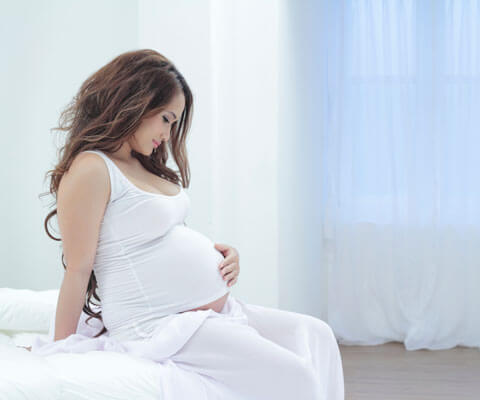
Against this background, experts advise leaving the lower limbs in a state of natural rest at night, unless there are some acute specific indications to the contrary.
It is equally important to learn how to properly put on a new item in your wardrobe. The difficulty here can be the presence of a large percentage of elastane. To put on a long stocking, you first need to pull it on your hand to the heel base. After this, the fabric tube is turned inside out.
The foot is inserted into the resulting hole, and then the instep is pulled to insert the entire leg. Some categories of victims find it difficult to cope with such a seemingly easy task on their own.
For pregnant women, the elderly, and those suffering from radiculitis, the developers have created a separate device to speed up the process of correct donning.
It's called butler. It works on the principle of a holder, onto which the desired item of clothing is immediately put on, then the lower limb is inserted, and only after that the mechanism is removed back.
How to choose compression stockings
Elastic knitwear against varicose veins includes models of different lengths. Some cover their entire legs. Others - only to the knee. It depends on the purpose of the compression stockings.
An important characteristic of underwear is pressure, which directly affects the effectiveness of knitwear. Stockings should fit tightly to your legs, but not cause pain.
Some models are designed specifically for operated patients. They are not suitable for other people.
The degree of compression of knitted stockings for the treatment of varicose veins will be determined by the doctor. Therefore, be sure to sign up for an examination and buy elastic underwear only after consultation.
Check the knitwear in the store. Choose products:
- Antimicrobial and hypoallergenic
- No seams
- With a service life of 12 months
- With RAL quality standard
With proper care, such underwear will last a long time and you will not have to change it until the end of the course of treatment.
Types of Compression Stockings
All models of slimming knitwear are divided into three types:
- Preventive
These products are not considered medical and therefore can be purchased even without a doctor's prescription. They simply support the blood vessels. This type of underwear reduces fatigue and pain in the legs. Knitwear puts little pressure on the veins and is great for preventing vascular diseases, but does not treat varicose veins.
- Medicinal
The most extensive group of elastic stockings. For these products, the level of pressure in different areas is different - near the ankle, the underwear compresses the most, and up the leg the pressure weakens. Therapeutic knitwear is prescribed by a doctor. Stockings are intended for people with varicose veins and thrombophlebitis.
- Anti-embolic or hospital
This underwear is prescribed to people who must remain in bed after surgery. It helps reduce the risk of deep vein thrombosis. High compression class. The pressure in different areas of the stockings varies, just like with medical products.
Yes, you can buy elastic underwear yourself to prevent vascular diseases. But we still advise you to consult a doctor. He will help you choose knitwear. The phlebologist will also tell you about other preventive methods, so you will learn to protect your veins much better.
Compression levels of compression stockings
According to the pressure level, elastic underwear is divided into four classes:
- Compression up to 22 mm Hg. Art. This knitwear helps stop the development of varicose veins - it removes swelling, spider veins and other signs of varicose veins.
- Pressure up to 32 mm Hg. Art. Second class stockings are prescribed to patients with chronic venous insufficiency, thrombophlebitis and varicose veins. Knitwear is also used for prevention by people with a sedentary lifestyle.
- Compression up to 46 mm Hg. Art. These stockings are worn by patients with trophic disorders and congenital defects of the vascular system.
- Pressure up to 50 mm Hg. Art. Doctors prescribe such knitwear only to people with severe forms of venous disease. Lingerie is used in the treatment of severe edema.
The correctly selected level of compression allows you to successfully combat vascular diseases, while unsuitable knitwear further harms the veins.
Choosing the right size of underwear is equally important.
Compression stockings size chart
Before purchasing underwear, be sure to take your feet measurements. Need to measure:
- Calf circumference
- Ankle circumference
- Thigh circumference
- Leg length from floor to hip
- Foot length
Take all measurements in the morning, after waking up. Do not get out of bed - this way you will achieve the most accurate results, which cannot be obtained in a standing position due to the pressure on the blood vessels. Recording your leg measurements will be useful when using the stocking size chart.
| Size | Height, cm | Weight, kg | Hip volume, cm |
| S; S1 | 150 – 162 | 41 – 55 | 90 – 100; 90 |
| M; M1 | 152 – 170 | 55 – 75 | 88 – 100; 98 – 115 |
| L; L1 | 155 – 175 | 58 – 95 | 113 – 130; 98 – 115 |
| XL | 167 – 180 | 68 – 95 | |
| XXL | 160 – 178 | 85 – 108 |
Anti-embolic (hospital) stockings Ergoforma
Ergoforma anti-embolic stockings are suitable for use in the postoperative, postpartum period and in bed rest after strokes and heart attacks.
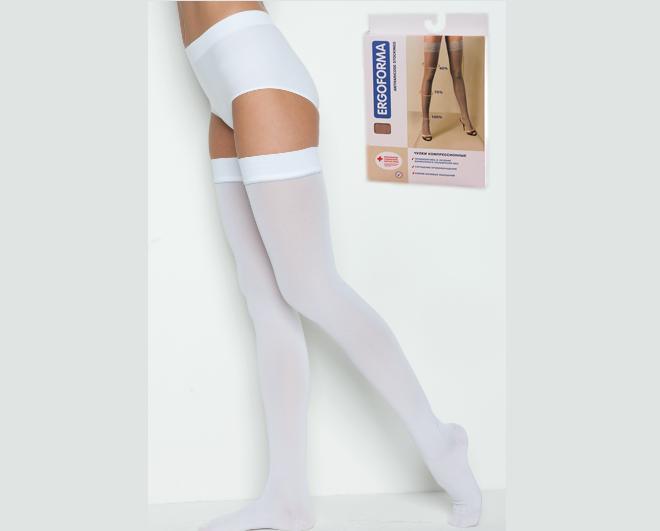
Features of Ergoforma products:
- contribute to the normalization of the outflow of venous blood due to graduated compression on the muscles and venous wall;
- suitable for women and men;
- the wide silicone elastic band in the upper third of the thigh does not exert excessive pressure, and the hole under the distal part of the foot promotes effective air and moisture exchange;
- a special hole under the fingers allows you to monitor the state of blood microcirculation.
How to put on and wear compression stockings correctly
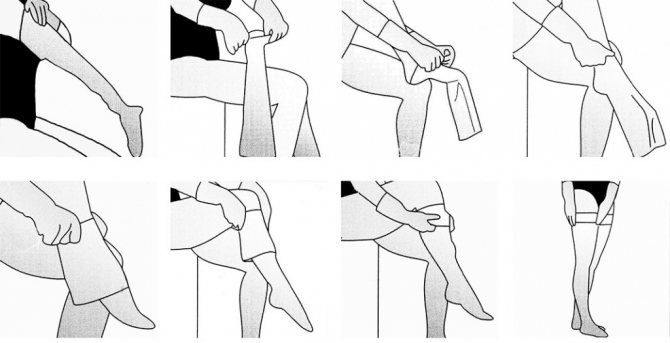
First of all, put on elastic underwear immediately when you get up. Without even getting out of bed.
Raise your leg. It should be above the level of the heart - in this position the pressure in the vessels decreases. Carefully slide your foot inside and slowly pull the fabric up.
Smooth out your stockings. They should fit snugly to the skin. Smooth out the folds. The top of the underwear should not be folded down, otherwise the knitwear will press like a tourniquet, and as a result, blood circulation will be impaired.
It is not recommended to remove compression stockings during the day. Only in the shower or bath. Before going to bed, lie on your bed and elevate your legs. Then take off your underwear.
How long should knitwear be worn?
Ask your doctor. Mild forms of varicose veins can be eliminated in a few months, but chronic diseases are a more serious problem. Sometimes phlebologists recommend that patients wear elastic stockings for several years. In rare cases - all your life.
If treated carelessly, knitwear will not last even a few months. Therefore, it is necessary to properly care for it.
Why can't you do without compression garments?
Wearing compression (therapeutic) knitwear is recommended:
- For the prevention of varicose veins, at increased risk or at the onset of the disease.
- For medicinal purposes, when varicose veins have already appeared or complications have arisen - trophic ulcers, thrombophlebitis.
- During planned operations and in the postoperative period - to reduce the risk of blood clot formation. The duration of wearing during rehabilitation may vary, but for major operations we can talk about several weeks.
Moreover, the hotter the weather, the more uncomfortable the stockings seem. But taking a break from wearing stockings can lead to the deterioration of the veins, and ultimately you will still have to return to treatment.
All venous diseases are chronic, take a long time to develop and are difficult to treat. Therefore, you need to constantly fight them.
Caring for compression stockings
The stockings do not look like a durable product. And indeed, usually their service life does not exceed 12 months, and in many cases the linen breaks and becomes unusable even earlier.
What to do?
First of all, stockings need to be washed. Including knitwear with antimicrobial protection. Remember - you wear elastic underwear all day and dead skin cells constantly accumulate on it. So wash it daily.
It's best to do it manually.
For washing, use baby soap or other delicate products that will not damage the knitwear. You cannot boil laundry.
After washing, squeeze the water out of the stockings very carefully. Do not stretch them, otherwise you will damage the fabric. You can remove moisture with a towel.
Dry knitwear on a flat surface only in cool or warm places, as extreme heat can destroy the material.
Even with proper care, stockings will sooner or later lose their elasticity. Sometimes after just a few months. Less often - after a year.
How to change knitwear in time?
The loss of elasticity is easy to notice in the morning when you put on stockings. Old compression garments stretch very easily. Hence the conclusion - it no longer grips the legs with the required strength and therefore it is necessary to buy a replacement.
Anti-embolic stockings "INTEX"
A specially developed technology for knitting products and the use of hollow threads allows you to effectively remove moisture from the skin, improve air exchange, facilitate skin breathing, which makes wearing knitwear as comfortable as possible.
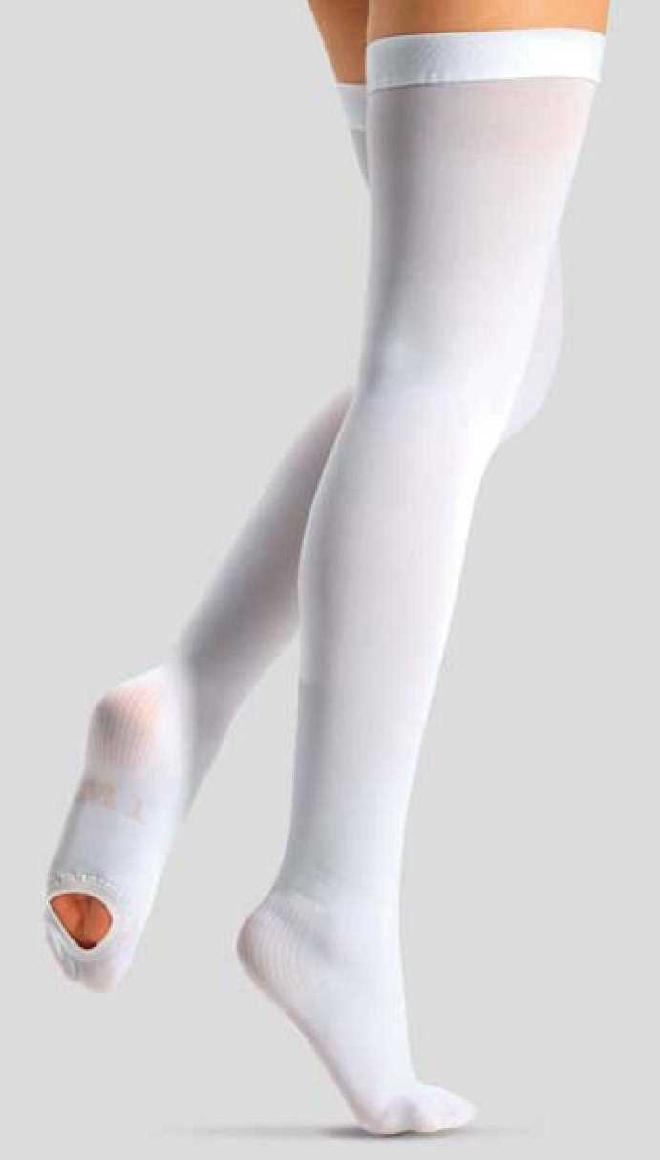
Advantages of INTEX anti-embolic stockings:
- “INTEX” stockings are made using a special technology (with a hole in the toe part of the stocking), which makes it easier to monitor the patient’s condition during and after operations;
- the products have an elastic band with dotted silicone for secure fixation on the leg;
- anti-embolic knitwear "INTEX" is produced in accordance with the standard and is hypoallergenic;
- soft elastic band that does not interfere with blood flow;
- reinforced toe and heel parts increase the wear resistance of the product;
- a lace elastic band on a silicone base decorates and softly fixes the stocking on the leg;
- beautiful appearance.
Anti-embolic hospital stockings for surgery can be purchased at a competitive price in our orthopedic salons in Rostov-on-Don, Azov and Bataysk.
Share on social media networks:
How long to wear compression stockings after surgery
Elastic knitwear is not only included in the complex treatment of vascular diseases and is used to prevent varicose veins. This type of underwear is also prescribed to patients who have undergone surgery. Sometimes for several days. In other cases for months.
The duration of wearing stockings is determined by the doctor.
After treatment, the knitwear must be used for different times, depending on the procedure:
- Caesarean section - up to three weeks
- Hysterectomy – two to eight weeks
- Laparoscopy – from three days to a month
- Kidney removal - from five days to four weeks
- Removal of the gallbladder - from ten days to a month
How long to wear compression stockings after sclerotherapy?
It is necessary to take into account the number of vessels that the doctor treated. During the operation, the phlebologist uses different methods to destroy the inner walls of the veins, causing them to become inflamed. Blood circulation in the vessel stops, and after some time the diseased vein completely disappears. Blood moves through other vessels.
In this case, compression stockings help keep the treated veins closed and prevent blood from entering them. Therefore, the vessels disappear faster.
Elastic underwear should be worn for up to four months if the doctor has operated on one or two veins. A larger number of removed vessels must be maintained longer—six months. Moreover, this is not a full term. The patient wears second-class knitwear for so long, and then the doctor can replace it with first-class underwear.
Constriction stockings are also used in other vein surgeries. For example, they are useful for recovery from phlebectomy and miniphlebectomy.
But endovasal treatment does not require compression therapy, and underwear is used only if signs of venous insufficiency persist - edema and trophic disorders.
Unfortunately, this information is not universal. It cannot be applied to absolutely every situation and every person. The doctor prescribes hosiery and determines how long patients should wear special stockings.
Reading about elastic underwear is a good start, but the real fight against vascular disease will only begin after a visit to the doctor.
How to put on and take off compression stockings correctly
Compression hosiery must be worn correctly on your legs so that it has the necessary effect and is worn longer. Before putting on compression stockings or tights, you need to prepare:
- Trim and file your nails with a special nail file;
- Remove roughness and calluses on the feet with pumice stone;
- Let your legs rest for 15 minutes, placing your feet on a pillow;
- Wash and dry your feet thoroughly;
- Wear thick medical gloves on your hands.
After all the preparations, start putting on stockings. First, turn the compression product inside out and put it on your arm. Then insert the foot into the sock and carefully pull the product up to the heel, simultaneously pressing the foot inward. After putting the stocking on the foot, centimeter by centimeter, pull the rest of the product onto the lower leg and thigh, carefully straighten out the unevenness and folds with your fingers. You should also remove the compression stockings carefully so as not to damage them. If you need to choose compression tights or stockings after vein surgery, make an appointment with a phlebologist at the Yusupov Hospital by calling. The nurse will teach you how to properly put on, remove, and care for the compression product.
Some tips
- Stockings or knee socks must be selected strictly according to size. This is necessary primarily for the therapeutic effect, but it also affects the wearing comfort. Stockings should not overly pinch the leg or slide down. Each series of stockings has several size options so that you can choose for any ratio of height, fullness of the lower leg and thigh, and foot size.
- If the silicone in the upper part of the stockings irritates the skin, this can be especially problematic in the summer, in the heat, when the skin sweats, pay attention to models with a belt fastening with the addition of cotton - they do not have silicone inserts.
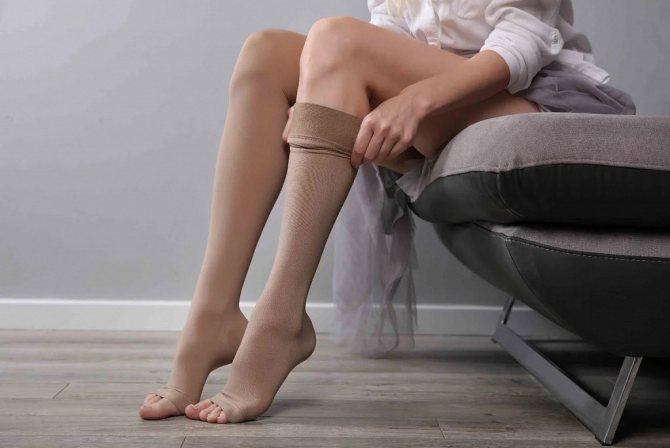
- For summer, it is better to choose models with an open toe - they are easier and more comfortable to wear. You can wear them with shoes that show your toes. Such models are, for example, in the Sigvaris Top Fine Select series.
- If you want to completely hide your tights or stockings, pair your stockings with maxi skirts. Due to the fact that the stockings fit tightly to the skin, do not cause irritation and do not retain sweat, it will not be hot in them, and no one will notice them at all in a long skirt.
- Think about your vacation plan. What products will you wear to get to your vacation spot? What will you wear to an evening promenade around the southern city or to a gala concert? Which compression stockings will be comfortable for you to go on a one-day excursion where you need to walk a lot? Some maritime regions have high humidity, will washed stockings dry overnight? It may make sense to take several pairs of stockings or golf with you.
By refusing (if indicated) from compression hosiery in the summer, you do not get more comfort, but deprive yourself of it. And besides, you risk suffering from an exacerbation of the disease in the future, and then you will still have to be treated. Therefore, it is much better to go to see a doctor in advance, get a consultation and choose the type of stockings or socks that will be most comfortable for you.
The psychological attitude when using compression stockings in the summer is no less important than correctly selected compression underwear. Wearing compression garments in the summer, in the heat, is our conscious choice, our concern for our own health. And to make this choice as comfortable as possible, combine different product options: stockings, knee socks; try products with an open toe; products with added cotton. You will definitely find your own version of compression garments for the summer and your veins will thank you.
Did you like the article? Subscribe to our Instagram and YouTube! More useful information, current promotions and reviews of Sigvaris products!
Lingerie after breast augmentation
After surgery for breast augmentation with implants, or surgery for removal of the mammary gland and its immediate restoration with an implant, you need a compression bra WITH A TOP ELASTIC that secures the breasts in the upper pole. Sometimes such elastic is built into the bodice from the sides, sometimes it is attached to it separately with Velcro at the back, as in these photos. Please note - this elastic band must be tight - fastened with tension, otherwise it “does not work”.
|
|
In this case, the upper edge of the lower elastic (under the breast) should be strictly in the submammary fold and not go over the implant - so as not to “squeeze” it upward. To do this, do not make the top straps of your underwear too short. The upper elastic band should push the chest down towards the navel, preventing the implants from moving upward.
|
|
In these photos of the girl after breast augmentation with implants, the straps of her underwear were too short. If you fasten them, the lower elastic band goes over the implant and risks moving it upward.
That's why we don't fasten the straps: the lower elastic with its upper edge is in the fold just under the chest, and the upper one presses on top.
Lingerie after liposuction
We perform liposuction and lipofilling on some of our patients (we take fat from the abdomen or other problem areas through punctures and transplant it through punctures to a new place). As a rule, this is done to prepare tissue for installation of an expander or implant - under the skin of the breast (when restoring the breast after its removal) or to enlarge the breast, correct its shape, or to correct the shape of the buttocks.
To reduce the risk of bruising and hematomas in the fat harvesting areas, after surgery, patients are recommended to wear compression garments that fit and press against these areas. At the same time, in the area where the transplanted fat is located (on the chest), wearing compression garments is not required: so as not to squeeze the vessels and not disrupt its nutrition.
Scar Remedy
The invisibility of scars after surgery depends on:
- the skill and skill of the surgeon in choosing the “right” location of the incisions and applying a cosmetic suture
- suture materials that the doctor uses during surgery (see HERE for more information). Many of them are not used for treatment under the compulsory medical insurance policy.
- patient's skin characteristics
- products that are used after surgery (their use is not covered during treatment under the insurance policy)
Immediately at the end of the operation, the doctor may use Dermabond skin adhesive. Traditionally, this is not done due to the increased cost of treatment. Discuss with your doctor before surgery whether he can use it if you buy it yourself.
If Dermabond was not used immediately after surgery, hydrocolloid dressings (convatec granuflex hydrocolloid dressing) can be used in the early postoperative period (the day after surgery). Traditionally, this is not done due to the increased cost of treatment.
If you buy them yourself, you can stick them on the wounds the next day after surgery.
| Granuflex Thin (Granuflex) 10 x 10cm, hydrocolloid dressing, extra thin You can cut strips or circles out of it with scissors - for sticking on postoperative wounds. They need to be changed every 2-3 days, washing with soap. |
If the wound has already healed, silicone plates, creams, ointments, etc. can be used:
- Silicone gel Kelo-Cote or Dermatix.
- Clovermed Xeragel Silicone Gel and Pro-Sil Silicone Stick
- Silicone plates Epi-Derm Areopexy, Mastopexy form Areola circles from Clovermed
- Epifoam sheets after liposuction to reduce swelling
- Silicone plates Elastoderm from Native
- Bio-Oil
- Much more - see more HERE

